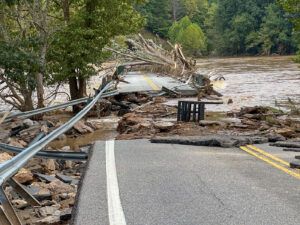Climate change adaptation can seem like an insurmountable challenge for many municipalities. Strategies on how best to combat climate change impacts are often presented through general recommendations or through specific activities that are not applicable across all municipalities.[i] Matched with the scarcity of public dollars to implement wide-sweeping policy changes to address climate change, municipalities face tough choices on how best to address climate change challenges specific to their community. Before solutions can be discussed, municipalities must determine exactly how their community is impacted by climate change. Obtaining and analyzing historical climate data and utilizing climate change projection models are often outside the scope of many municipalities. Instead, the reliance on external experts to assist in this analysis puts municipalities at a disadvantage as it can be expensive to retain external experts to provide this crucial information.
Once a local government has managed to determine the direct impacts of climate change in their community, solutions can be difficult to implement due to a lack of funding and political will. Upgrading infrastructure to better handle more severe and frequent climate events is a financially straining practice. The distribution of political capital may not align with the communities most likely to be affected by climate change, contributing to an increased funding gap for the most vulnerable of areas.[ii]
Additionally, there may be a misalignment in the definition of strategy. Many confuse mitigation strategies with adaptation strategies. Mitigation strategies are strategies that focus primarily on decreasing the environmental footprint of the municipality and consist of actions that limit the magnitude or rate of long-term global warming and its related effects.[iii] These strategies include things like investments into green and alternative energy solutions and programs to offset the carbon footprint of municipal operations, to name a few examples. Adaptation strategies, however, look to improve the municipality’s and surrounding community’s capacity to absorb the increased severity and frequency of climate events.
With all these issues that can occur, it is easy to understand the significant barriers that municipalities across Canada face in dealing with climate change. However, solutions to some of these problems currently exist. Climate change assessment frameworks are often available to municipalities at no cost. This allows municipalities to develop an initial process that can help guide them down the path of climate change adaptation. Examples of such frameworks are the UKCIP Wizard from the University of Oxford, the PIEVC Protocol from Engineers Canada, and the Coastal Community Adaptation Toolkit from the Atlantic Climate Adaptation Solutions Association (ACASA).
Further, to counter the funding deficit that many municipalities face, the Government of Canada has routinely offered – and continues to offer – federal dollars to municipalities interested in investigating climate change impacts on their community and developing climate change adaptation plans. In 2009, Natural Resources Canada established the Regional Adaptation Collaborative and Tools Program to advance adaptation decision-making initiatives in communities and sectors across Canada. One such community that utilized this funding opportunity was the City of Moncton in partnership with ACASA.
The City of Moncton utilized this funding to hire a consultant to perform a climate change impact study. This study outlined the specific climate risks that the City will face over the next 100 years and outlined key vulnerabilities that need to be addressed. A variety of solutions were proposed from the study and in 2013 the City developed a Climate Change Adaptation and Flood Management Strategy to formulate a structured plan to address these identified vulnerabilities.
Derived from the identified vulnerabilities, multiple steps were suggested to improve climate change adaptation outcomes. The steps are segregated into two main categories: (i) modification of existing infrastructure to meet new standards, and (ii) adoption of new building codes to prevent future adaptation issues. Modification of existing infrastructure is an ongoing and continuous process with extensive impacts and facets of difficulty; these projects are more likely to be affected by funding deficits and political imbalances. Solutions are slow-moving, but progress is being made within the City.
In an effort to implement new building codes, the City passed By-Law Z213 on January 20, 2014. This By-law, among other things, changed the minimum requirements of geodetic elevation for new development of occupied floor space or parking garages to 10.5 meters. This meant that no new development could be approved unless the minimum elevation for that development was above 10.5 meters. The City of Moncton has an average geodetic elevation of approximately 29 meters, however, there are numerous locations and neighborhoods throughout the City that are well below the new minimum elevation requirement of 10.5 meters. Additionally, setbacks from watercourses were moved to 30 meters, preventing new developments from being built in higher-risk zones.
The City of Moncton has an average geodetic elevation of approximately 29 meters, however, there are numerous locations and neighborhoods throughout the City that are well below the new minimum elevation requirement of 10.5 meters.
The elevation requirements, though a positive measured effort towards climate change adaptation, made urban design planning slightly more difficult. Locations for new development became scarcer with sections of the City designated as unable to be developed for commercial or residential purposes.
Senior Urban Planner, Sarah Anderson, explained the impact of the by-law as follows: “While it is not common for development projects to be denied, additional steps are required for developers to meet these standards, or at least have well-explained engineered solutions to alleviate any potential impact.” She also highlighted the permit-obtaining process for developers to assist with a smooth project implementation and compliance efforts: “We have a three-step building permit process, where the first step requires developers to submit plans that meet all by-laws and building requirements. Once they have met all the standards in the plans and have obtained their foundation permit, city inspectors are sent to validate the construction and developers can finalize their building project.”
Often, the most contentious projects are ones where developers want to install underground parking. These can be below the elevation requirements and result in developers having to build up to accommodate these restrictions.” Though she pointed to the existence of some development frustration, she emphasized that the most vulnerable areas in Moncton are the oldest. “Development in these areas has been mostly concentrated on revitalization projects of existing buildings and infrastructure instead of new development projects.”
Ultimately, the by-law change has been successful in progressing climate change adaptation for new developments. It has set clear guidelines for developers to ensure that new projects will not cause problems in the near future for the City. This has allowed an increased focus on revitalization projects to bring existing infrastructure up to acceptable standards. Climate change adaptation is a slow-moving process; any action that can assist with simplifying the path towards better adaptation strategies is vital. Moncton has shown itself to be a viable example of how preparing for the future is just as important as bringing existing infrastructure up to current standards.
WILLIAM KLUSKA, MPP holds an honour’s bachelor’s degree in Economics from Acadia University and a master’s degree in Public Policy, focusing on economic policy, from the University of Calgary. William’s research has primarily focused on the economic impacts of the payday lending industry in Canada. William has also spent time assisting research on the economic impacts of tourism in Atlantic Canada. In his current role, William produces applied research projects, focusing on municipal government and infrastructure.
[i] Moser, S. C., and J. A. Ekstrom. “A Framework to Diagnose Barriers to Climate Change Adaptation.” Proceedings of the National Academy of Sciences 107, no. 51 (June 2010): 22026-2031. doi:10.1073/pnas.1007887107.
[ii] Aaberge, Rolf, Manudeep Bhuller, Audun Langørgen, and Magne Mogstad. “The Distributional Impact of Public Services When Needs Differ.” Journal of Public Economics 94, no. 9-10 (2010): 549-62. doi:10.1016/j.jpubeco.2010.06.004.
[iii] Giorgi, Filippo. “Climate Change: Key Conclusions From The Ipcc Fourth Assessment Report (Ipcc-Ar4).” International Seminar on Nuclear War and Planetary Emergencies — 38th Session, 2008. doi:10.1142/9789812834645_0011.



